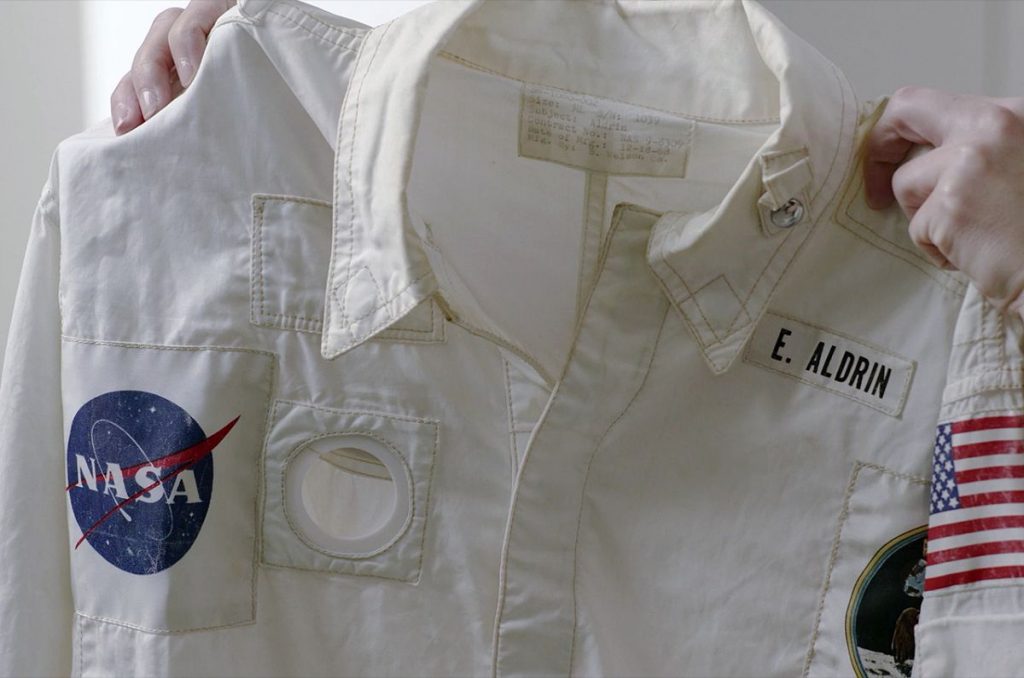
Sotheby’s to auction Buzz Aldrin’s Apollo 11 moon landing artifacts (Image Credit: Space.com)
You could call it a “magnificent disposition.”
Adapted from Buzz Aldrin‘s words (“magnificent desolation”) when he became one of the first humans to walk on the moon 53 years ago this week, Sotheby’s is set to offer artifacts from the Apollo 11 astronaut’s personal collection (opens in new tab), including items that were instrumental in the first lunar landing mission.
“These objects not only witnessed mankind’s greatest achievement, but many of them made that achievement possible,” Cassandra Hatton, Sotheby’s global head of department and senior specialist for science and pop culture, said in a video preview (opens in new tab) of the auction house’s July 26 sale. “These are important historic artifacts from that greatest moment in human history. They remind us of what mankind can accomplish.”
Related: Apollo 11: First Men on the Moon
A member of NASA’s third group of astronauts selected in 1963, Buzz Aldrin conducted three spacewalks on Gemini 12, the last mission to use the two-man spacecraft, three years before landing on the moon with Neil Armstrong in 1969. Today, at 92, he is the last surviving member of the Apollo 11 crew (Armstrong died (opens in new tab) in 2012 and command module pilot Michael Collins died (opens in new tab) in 2021).
“The sale covers the full scope of Dr. Aldrin’s career, starting with his doctoral work at MIT, where he wrote his PhD thesis on the lunar module rendezvous technique, to mission artifacts from Gemini 12, where he did his first spacewalk, and objects from the greatest mission, Apollo 11,” said Hatton.
Although not the first auction to offer items from Aldrin’s collection (opens in new tab) — he and and his family members have consigned memorabilia to sales dating back to the early 1990s — Sotheby’s catalog stands out for the historic nature of the artifacts that are up for sale. A 2012 law confirmed that the Apollo-era astronauts retained title (opens in new tab) to the space-flown equipment they kept as mementos.

Among the sale’s highlights is a felt tip pen and the broken nib off a circuit breaker switch that were critical to Aldrin and Armstrong leaving the lunar surface.
“There weren’t guards over any of the circuit breakers. One got pushed in and one got broken off. So I must have pushed one in and broke one off,” Aldrin told the editor of the Apollo Lunar Surface Journal, describing the accident in the “Eagle” lunar module in a 1991 interview.
As it happened, the broken switch was required to arm the lander’s ascent engine. While flight controllers in Mission Control devised a software solution, Aldrin came up with an idea of his own.
“Buzz ingeniously pulled a felt tip pen out of the pocket of his sleeve,” said Hatton. “Amazingly, the tip of that pen fit perfectly into the hole where the broken switch was. He stuck it in there and, miraculously, the engine was able to ignite and they were able to reassemble and meet up with Mike [Collins] and get back home.”
The Duro-brand ink marker and the plastic nib, which in 2017 were loaned to the Smithsonian for a two-year, five-city tour with the Apollo 11 command module (opens in new tab), are expected to sell for $1 to $2 million.
Sotheby’s is also offering the jacket Aldrin wore on the Apollo 11 mission when he was not wearing his spacesuit.
“It’s got the NASA emblem, the Apollo 11 eagle emblem, his name and American flag, and some of the most famous pictures from the mission, other than the actual moonwalk, are of Buzz wearing this jacket in the spacecraft,” Hatton said. “There is no other garment worn on this mission that can be owned privately.”
The spacesuits Aldrin and Armstrong wore on the surface of the moon, as well as the inflight coveralls that were donned by Armstrong and Collins are in the care of the Smithsonian’s National Air and Space Museum. Aldrin’s jacket is expected to sell for $1 to $2 million.

Other highlights from the “Buzz Aldrin: American Icon” sale include complete Apollo 11 documents and checklists used to carryout the mission and a “Go Army, Beat Navy” banner that Aldrin carried on one of his Gemini 12 spacewalks.
“Prior to Gemini 12, Gemini 6 [launched] just before the 1965 Army-Navy football match. So in the window of the Gemini 6 spacecraft, Wally Schirra and Tom Stafford put up a “Beat Army” sign. So when Gemini 12 came around, Buzz was in the spacecraft with [Jim] Lovell who was Navy and Buzz was Army, so when he was floating around in space, Buzz pulled out of nowhere this amazing ‘Go Army, Beat Navy’ banner,” said Hatton.
Sotheby’s expects the black-and-white cloth sign to command $20,000 to $30,000.
In addition to space-flown artifacts, the sale also features memorabilia, including flown flags, philatelic covers (stamped and postmarked collectible envelopes), the “Moonman” MTV VMA award statuette (opens in new tab) presented to Aldrin and his Presidential Medal of Freedom.
The “Buzz Aldrin: American Icon” sale (opens in new tab) will be held at Sotheby’s New York City gallery beginning at 12 p.m. EDT (1600 GMT) on Tuesday, July 26. An exhibition of the auction’s lots will begin Thursday (July 21) through July 25.
Follow collectSPACE.com (opens in new tab) on Facebook (opens in new tab) and on Twitter at @collectSPACE (opens in new tab). Copyright 2022 collectSPACE.com. All rights reserved.






